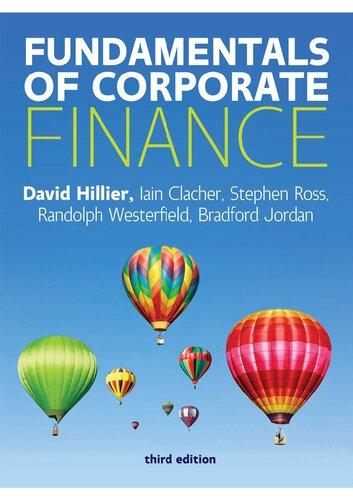Project Evaluation This is a comprehensive project evaluation problem bringing together much of what you have learned
Question:
Project Evaluation This is a comprehensive project evaluation problem bringing together much of what you have learned in this and previous chapters. Suppose you have been hired as a financial consultant to Defence Electronics International (DEI), a large, publicly traded firm that is the market share leader in radar detection systems (RDSs). The company is looking at setting up a manufacturing plant overseas to produce a new line of RDSs. This will be a five-year project. The company bought some land 3 years ago for £4 million in anticipation of using it as a toxic dump site for waste chemicals, but it built a piping system to discard the chemicals safely instead. The land was appraised last week at £5.1 million. In 5 years the after-tax value of the land will be £6 million, but the company expects to keep the land for a future project. The company wants to build its new manufacturing plant on this land; the plant and equipment will cost £35 million to build. The following market data on DEI’s securities are current:
Debt: 2,400,000 7.5 per cent coupon bonds outstanding, 20 years to maturity, selling for 94 per cent of par; the bonds have a £100 par value each and make semi-annual payments.
Equity: 9,000,000 shares outstanding, selling for £71 per share; the beta is 1.2.
Preference shares:
400,000 of 5.5 per cent preference shares outstanding, selling for £81 per share.
Market: 8 per cent expected market risk premium; 5 per cent risk-free rate.
DEI uses G.M. Wharton as its lead underwriter. Wharton charges DEI spreads of 8 per cent on new equity issues, 6 per cent on new preference share issues, and 4 per cent on new debt issues. Wharton has included all direct and indirect issuance costs (along with its profit) in setting these spreads. Wharton has recommended to DEI that it raise the funds needed to build the plant by issuing new shares of equity. DEI’s tax rate is 28 per cent. The project requires
£1,300,000 in initial net working capital investment to get operational. Assume Wharton raises all equity for new projects externally. Assume that the face value of a preference share is £100.
(a) Calculate the project’s initial time 0 cash flow, taking into account all side effects.
(b) The new RDS project is somewhat riskier than a typical project for DEI, primarily because the plant is being located overseas. Management has told you to use an adjustment factor of +2 per cent to account for this increased riskiness. Calculate the appropriate discount rate to use when evaluating DEI’s project.
(c) The manufacturing plant has an eight-year tax life, and DEI uses 20 per cent reducing-balance depreciation. At the end of the project (that is, the end of year 5), the plant and equipment can be scrapped for £6 million. What is the after-tax salvage value of this plant and equipment?
(d) The company will incur £7,000,000 in annual fixed costs.
The plan is to manufacture 18,000 RDSs per year and sell them at £10,900 per machine; the variable production costs are £9,400 per RDS. What is the annual operating cash flow (OCF) from this project?
(e) DEI’s financial controller is interested primarily in the impact of DEI’s investments on the bottom line of reported accounting statements. What will you tell her is the accounting break-even quantity of RDSs sold for this project?
(f) Finally, DEI’s chief executive wants you to throw all your calculations, assumptions and everything else into the report for the chief financial officer; all he wants to know is what the RDS project’s internal rate of return (IRR) and net present value (NPV) are. What will you report?
Step by Step Answer:

Fundamentals Of Corporate Finance
ISBN: 9780077178239
3rd Edition
Authors: David Hillier, Iain Clacher, Stephen A. Ross





